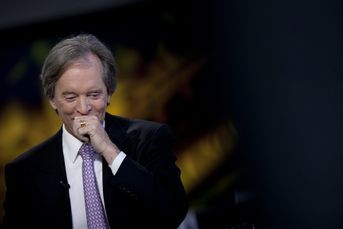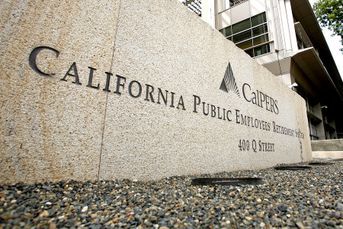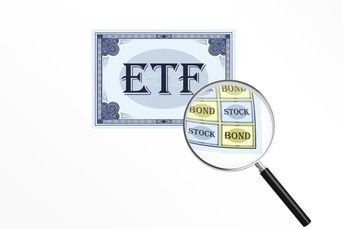ETFs give new meaning to the term ‘cross-selling’
MONEY MANAGERS are using more and more of one another’s exchange-traded funds as portfolio tools — significant because…
MONEY MANAGERS are using more and more of one another’s exchange-traded funds as portfolio tools — significant because ETFs are the only major example of an instance in which investment management firms are using their competitors’ products.
One factor is that managers have more ETFs from which to choose: The number of ETFs had grown to 1,134 as of Dec. 31, from 629 at the end of 2007.
“With product proliferation, it opens up opportunities to use them in different ways,” said Andrew McCollum, a consultant with Greenwich Associates who has studied ETF growth among institutional money managers. “Just three years ago, the use of ETFs was much more narrow.”
BlackRock Inc., the largest money manager and ETF provider in the world (through its iShares unit), is one of the largest users of other firms’ exchange-traded funds, according to an analysis by State Street Global Advisors.
BlackRock had $8.9 billion invested in 98 different ETFs at the end of 2011, of which about $2.8 billion was in other firms’ offerings. It had $1.7 billion with SSgA, $436.2 million with The Vanguard Group Inc., $410.3 million with ETF Securities LLC, $176.4 million with Van Eck Global, $52.1 million with Sprott Asset Management LP, $22.5 million with Invesco PowerShares Capital Management LLC and $1.1 million with WisdomTree Funds.
BlackRock’s ETF holdings are only a small piece of its $3.5 trillion under management.
Another big user of other firms’ ETFs among large money managers is Pacific Investment Management Co. LLC, which had $2.9 billion invested in ETFs at year-end 2011, of which more than $2.1 billion was in other companies’ funds, according to SSgA. The bulk was invested in just two: $1.2 billion in the Vanguard Emerging Markets ETF and $893.7 million in SSgA’s SPDR Gold Shares.
Pimco’s numbers have been rising. Spokesman Michael Reid said that as of March 1, total Pimco ETF assets were about $3.75 billion.
SSgA had $4.3 billion in ETFs, of which $1.9 billion was invested in other providers’ products. It had $990 million with BlackRock, $860.4 million with Vanguard, $28.9 million with PowerShares, $9.4 million with Pimco and $3.2 million with Van Eck.
A survey last May by Greenwich Associates found that traditional uses of ETFs are still popular, with three-quarters of money managers surveyed using them for cash equiti- zation or interim beta, and 45% using them during manager transitions.
But it also found that 40% use exchange-traded funds as part of their regular re-balancing procedures, 40% use them to make tactical adjustments to their portfolios, and 30% for hedging. Another 10% reported using ETFs for liquidity management.
It’s all about liquidity, said Gus Sauter, Vanguard’s chief investment officer. “The reason is to maintain liquidity, so obviously, one thing that is very important to us is to invest in the most liquid ETFs in their space. In that particular segment of the market, the SPDR is the most liquid. Even though we have a competing ETF, it’s not as liquid, so we are just trying to provide the best value for our clients.”
Vanguard’s S&P 500 ETF has $3 billion in assets; SSgA’s SPDR S&P 500 has $99 billion.
Mr. Sauter said that as the Vanguard ETF grows larger, the company will migrate to its own product.
RULE OF THUMB
“A good rule of thumb is: The broader the potential instrument and asset classes a manager is allowed to use in a portfolio, the more likely they are to make use of ETFs,” said consultant David Bauer, a founding partner of money manager consultant Casey Quirk & Associates LLC.
He said that the use of ETFs in portfolios is part of a broader trend in money management: a focus on risk-return outcomes rather than on outperforming a specific benchmark.
“The value added in many of these new multiasset products is not the actual stock pickings,” Mr. Bauer said. “It’s the integration and construction of a portfolio made up of a variety of asset classes. ETFs are really an efficient way to express a broad view on a particular asset class or to get exposure to a certain type of security.”
“We would use ETFs because they are a liquid, cost-effective way to gain exposure, as opposed to buying all of the direct, physical securities, which could take more time and complexity,” said Daniel Farley, senior managing director and chief investment officer of the investment solutions group at SSgA. “An example would be our positions in gold. The ETF has been an effective way to get that exposure.”
Mr. Farley, whose group has $60 billion in multistrategy assets, said another example would be a dividend-paying-equity ETF.
“For the larger institutional investors, who are able to use derivatives, futures are still used the most, particularly for those asset classes where futures are a perfect match or reasonable proxy,” Mr. Farley said. “The amount we would have positioned in ETFs is variable, based on the market environment. The role ETFs play has been increasing over time but still is not the leading implementation for institutional multiasset class portfolios.”
Mr. Farley said ETF use is small in portfolios devoted to a single strategy, such as domestic small-cap or large-cap equities, where investors expect their managers to hold specific stocks. He said standard asset classes have sufficient liquidity and access to the futures market, reducing the need to use ETFs.
INSTITUTIONALS WARY
Some institutional investors limit ETF use. An official of one money management firm, who asked not to be identified, said contracts between her firm and pension fund clients prohibit the use of exchange-traded funds because they don’t believe ETFs, which are largely passive, fit into the active management role for which the firm was hired.
Some pension fund officials, however, are lifting their restrictions, said Eileen Neill, managing director at Wilshire Associates Inc.
“There has been an increase in the use of ETFs by investment managers and by plan sponsors,” she said. “There is increased flexibility, so if they weren’t allowed before in plan sponsor guidelines, then they are starting to be allowed now.”
Liz Tennican, iShares managing director, said usage is increasing as contracts are rewritten. “Contrary to the lingering misconception that active managers don’t use passive ETFs, money managers always have been the largest institutional users of iShares ETFs,” she said.
She said the company also is working with consultants to educate them about ETFs.
“As we see growing institutional usage and increased liquidity in ETFs, the consultant community is interested in how to best utilize ETFs,” she said. “That said, we are still in the early days of this adoption.”
Indeed, money managers using ETFs seem to be divided into two camps — those that use them sometimes and those that use them rarely.
Wayne Lin, a portfolio manager at Legg Mason Global Asset Allocation, said the unit of Legg Mason Inc. uses ETFs for the passive portion of target date funds for defined-contribution plans and in some multiasset-class mutual funds.
“We try to balance off the value- added of the active managers and pair it with the ETFs and put those two together so it will reduce tracking error and stay closer to the benchmark,” he said.
ETFs also provide another way to access strategies or markets for its multiasset-class funds that aren’t easily accessible through Legg Mason products, Mr. Lin said. One example is a real estate investment trust, he said. The company uses the Vanguard REIT Index Fund ETF.
James Norman is president of QS Investors LLC, which has $13 billion in assets, of which $3 billion is in target risk and target date funds for defined-contribution-plan clients. QS uses several hundreds of millions of dollars in ETFs in those funds at any given time.
Mr. Norman said that ETFs are used to gain hard-to-get exposure such as microcap companies; emerging-markets equities, debt and local currency debt; timberland; and Asian equities.
“STRONG BELIEVERS’
“We are strong believers” in using ETFs, he said. “As the market has evolved and grown, it has given us more choices to get new exposures.”
Vanguard invests in ETFs primarily as a tool to equitize cash.
Vanguard keeps 3% to 5% of assets in its externally managed mutual funds in ETFs to gain market exposure while the assets await investment from portfolio managers, Mr. Sauter said.
Among those in the other camp: Capital Group Cos. Inc., which includes the American Funds and institutional money manager Capital Guardian Trust Co., and has more than $1 trillion in assets. Capital’s portfolio managers use ETFs only on very rare occasions and only for cash equitization, said spokesman Chuck Freadhoff.
Brent Smith, chief investment officer of Franklin Templeton Investments’ multiasset strategies, said ETFs are not a big part of the company’s money management efforts.
ETFs are used selectively “to provide efficient exposure to an asset class for small positions where there isn’t a mutual fund alternative, or where necessary to shift the portfolio’s asset mix quickly while keeping trading costs lows,” he wrote in an e-mail.
The SSgA analysis shows that Franklin Templeton’s total ETF assets were $299.1 million as of Dec. 31, up from $35.9 million at the end of 2007. The assets were all in other companies’ ETFs; Franklin does not have an ETF line.
COST-SENSITIVE
Further growth of ETFs’ use by money managers in some areas, such as transition management, might be dependent on costs. Although ETFs are used for that purpose, so are index futures. The latter cost as little as 2 basis points, a fraction of the cost of an ETF.
“If the ETF cost comes down to just a couple of basis points, there should be much greater usage,” said Joe Keenan, managing director and head of global exchange-traded-fund services for The Bank of New York Mellon Corp.
He predicted that prices on similar passive-based products will be cut in the future as competition among ETF providers heats up.
Bob Browne, executive vice president and chief investment officer of Northern Trust Corp., said ETFs can be expensive.
“We remind clients that the purchase and subsequent sale of an ETF creates costs and should only be done when absolutely necessary,” he said. “Generally, futures are better for really short-term exposure, due to lower costs.”
One growth sector for ETFs has been mutual funds. A total of $26.7 billion in investments in ETFs in 2011 were made by fund managers, up from $2.9 billion in 2009, according to data from Lipper Inc.
For example, Vanguard invested $78.5 million in SSgA’s SPDR S&P 500 ETF Trust. Yet Vanguard has its own S&P product, the Vanguard S&P 500 ETF, according to Lipper data.
LARGEST HOLDINGS
At BlackRock, the $55 billion global allocation mutual fund had one of its largest holdings — a 1% allocation — in the SPDR Gold Shares fund in 2011, according to Lipper data. BlackRock runs its own gold ETF, whose shares also were in the global allocation fund to the tune of $28.5 million, according to Lipper.
BlackRock has increased its allocation to the SSgA gold ETF to 1.2% of the mutual fund, its second-biggest holding, according to the firm’s website. (Its largest holding, 1.3% of assets, is in Exxon Mobil Corp., according to the website.)
Fidelity Investments also has increased its use of ETFs, according to the SSgA analysis. It had $3.7 billion invested in ETFs at the end of 2011, up from $593.1 million at the end of 2007.
Fidelity invests in 249 different ETFs, all products of other companies, according to Lipper Inc. data. Fidelity has only one ETF.
Another growing segment of the ETF industry is investment firms whose clients include financial advisers.
Morningstar estimates that financial advisory firms have between $40 billion and $100 billion in ETF assets. The report found that the amount of ETF assets in managed-portfolio assets grew 43% in the 12-month period ended Sept. 30.
“The mushrooming of ETF products has fueled the growth of ETF asset allocation strategies,” said Andrew Gogerty, an ETF managed-portfolios strategist for Morningstar.
The largest firm offering managed portfolios using only ETFs, Windhaven Investment Management, has seen assets under advisement double to $9 billion in the past 12 months, said Bryan Olson, president of the subsidiary of The Charles Schwab Corp.
Randy Diamond is a reporter for sister publication Pensions & Investments.
Learn more about reprints and licensing for this article.






